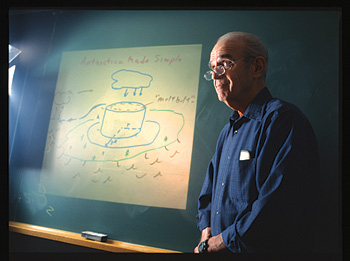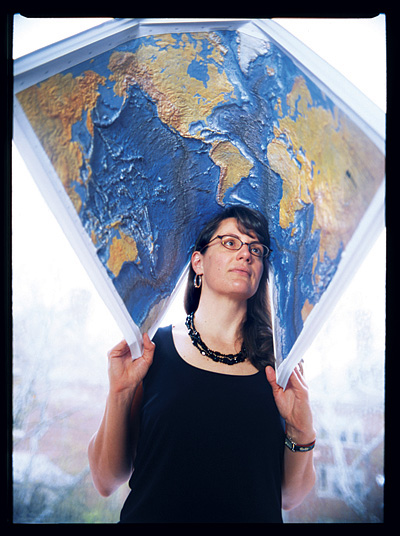We've all been hearing a lot about global warming in recent months, and as the presidential election approaches, we're going to be hearing a lot more. Yet how many of us really understand it? Millions of words have been written on the subject, partly because global warming is one of those rare problems that seem to affect every academic specialty. To fully comprehend global warming and its possible consequences, you'd need to be an expert in physics, chemistry, biology, sociology, economics, engineering, political science, agriculture, oceanography, and sociology, to name just a few of the disciplines now studying the problem.

And if your understanding of global warming comes from only one of those disciplines, your view of the problem is likely fragmentary and incomplete. Lost in all the praise and vilification Al Gore received for winning the Nobel Peace Prize last year is that he shared it with the Intergovernmental Panel on Climate Change (IPCC), a scientific group that has been bringing together researchers from many of those disciplines to make judgments and advise the rest of us. (One of the thirty-three authors of the final report on climate change that earned the IPCC its Nobel was University of Arizona professor of geological sciences and atmospheric sciences Jonathan Overpeck, who in the 1980s earned two graduate degrees at Brown, including his PhD.) Although the IPCC has its critics—indeed, given the politics of global warming, to spend even a few days reading about the subject you're in danger of concluding that scientists fall into two camps, incompetent blowhards or energy-industry stooges—it reflects the most comprehensive attempt at understanding what's happening and what is likely to happen.
So let's cut to the chase. The entire issue of global warming can be reduced to one fact and one question: The Earth is getting warmer. To what extent are humans responsible? "Warming of the climate system is unequivocal," the IPCC concludes. More difficult is the degree to which this is a natural development or one triggered by the 8.4 gigatons of carbon we pump into the air each year by burning fossil fuels. One answer is provided by Brown Professor Emeritus of Geological Sciences Robley Matthews, who states, "Man's input is minute compared to what is going on in nature." Matthews, whose view is shared by a minority of scientists, believes that the current alarm over global warming is driven by politics more than science and that scientists are just doing what any professional would do: following the money.
The IPCC, which represents more than 180 governments through the United Nations Environment Programme, concludes that greenhouse gases (GHG) in the atmosphere—mostly carbon dioxide but also including methane, nitrous oxide, and a couple of others—have increased 70 percent over the last thirty years. "Most of the observed increase in global average temperature since the mid-twentieth century," the IPCC says, "is very likely due to the observed increase in anthropogenic GHG concentrations."
This spring, senior writer Lawrence Goodman talked to Brown professors about their global-warming research. He found that, thanks to the scope and complexity of the problem, individual scientists can do little more than chew on little bits of it. Most of the scientists, such as Professor of Geological Sciences Tim Herbert, believe the future looks grim. "I'm pretty pessimistic," he says. "You can see how hard it is to change human behavior." Herbert adds, however, that "the planet will be fine. Life will be here, but it will be a very different planet." As far as solutions go, says Professor of Geological Sciences and Environmental Studies Jack Mustard, "There is no magic bullet out there." His own research involves studying the effectiveness of biofuels as an alternative energy source, but, he says, "Are we doing this the right way? I'm not sure yet."
Given that greenhouse gas emissions are likely to continue at or above current rates for the foreseeable future, much of the global warming research at Brown involves thinking about what the future will look like and doing as much as possible to preserve the Earth's biodiversity. Assistant professor of biology Dov Sax, for example, is studying the radical concept of "assisted migration," whereby scientists actually move threatened species to a new area as their original habitat degrades. This is the kind of thing evolution usually takes care of, but global warming is occurring so quickly that many species can't wait to evolve or migrate naturally. Paleobiologist Jessica Whiteside studies the geological record for evidence of how animals reacted to an earlier period of rapid warming. She concludes that the animals at the top of the food chain—humans occupy that spot today—were among the ones most likely to perish.
The following, then, is a snapshot of a few of the global-warming research projects under way at Brown.
Katherine Smith
Mosquitoes & Disease
Consider the water hyacinth. Up to three feet long with a rotund stem and a burst of lavender petals on top, it is one of the most destructive plants on the planet. And global warming, says Katherine Smith, a Brown conservation biologist, may make it even more lethal.

Smith will observe the depletion of oxygen in the water as the plant proliferates. Hyacinths require oxygen to grow, and their thick, voracious roots, she says, "do an excellent job of sucking it out." The result is suffocation of all other life in the lake, pond, or stream until only the hyacinths remain. Similarly, Smith expects the fish and invertebrates placed in her pond to also perish.
Smith predicts that large groups of mosquitoes will begin to swarm above the hyacinth-infested water. Fish would normally keep the mosquitoes in check by feeding on the insects' larvae, but without them, Smith says, the "mosquitoes would go gangbusters." (The experiment will be done in an enclosed environment to prevent any risk to public health).
In the early 1990s, water hyacinths spread rapidly across Africa's Lake Victoria. At about the same time, the surrounding towns and villages saw a significant uptick in cases of malaria. Smith believes the two were linked. Mosquito populations rose as the hyacinth spread, and mosquitoes transmit malaria. And the pattern could hold for other mosquito-borne diseases. In the United States, where malaria is not a problem, infected mosquitoes are the principal mode of transmission for West Nile virus.
Now what does this all have to do with global warming? Water hyacinth likes warm climates. Right now, the Northeast is cold enough to prevent the plant's spread north of New Jersey, but if the climate continues to warm, we may very well see an invasion of water hyacinths as far north as Canada. Increases in West Nile virus among humans may go hand-in-hand with it. That will be nothing though compared to what may happen in poorer countries, many of which lack effective means of controlling the weed's growth, not to mention adequate health care systems prepared to treat increased outbreaks of malaria.
All this remains conjecture right now because, according to Smith, no one has ever studied a link between water hyacinths on human health. "This is all brand new," says Smith, who doesn't expect to have any results for three to four years. Still, it's a reminder that global warming, as she points out, "can have multiple broad effects." From the perspective of public health, we're just beginning to learn what's coming.

Salty Hydropower
In the mid-1800s, a German scientist named Georg Hermann Quincke noticed that running saltwater through a glass tube generates electricity. But the amount of energy was so minute it was quickly abandoned as a viable source of electrical power. For the next 150 years, no one considered that there might be a practical application for Quincke's discovery.
Along came assistant professor of physics Derek Stein, who now believes that this miniscule electrical charge could become a significant new source of alternative energy. Stein is an expert in nanotechnology, and, armed with glass tubes whose diameter is ten thousand times smaller than a human hair, he plans to execute a modified twenty-first-century version of Quincke's experiment with the goal of capturing and then putting to use the electrical energy. Thanks to the rise of nanotechnology in recent years, we now can manufacture billions of these tiny tubes relatively inexpensively. If enough are joined together, Stein predicts, the tubes may be able to run an iPod or to provide a battery in an electric car with an additional source of power. And even a trillion nanotubes packed together could still fit on a postage stamp.
Why does saltwater produce electricity this way? As salt dissolves in water, its constitutive elements—sodium and chlorine—break apart. Both atoms become ionized in the process, with chlorine taking on a negative charge and sodium a positive one. This ordinarily leaves a soup of positively and negatively charged ions distributed equally, but here's where the glass comes in. A small amount of glass—only that on the material's surface—also breaks apart in water. In turn, the surface becomes negatively charged. As a result, positively charged sodium atoms draw near it, creating a charged layer of fluid along the sides of the tube.
An electrical current is nothing more than a group of positively charged atoms flowing together in the same direction.So when the water flows through the tube, taking the sodium ions along with it, that's exactly what's created.
Stein predicts that by using tubes made from chemically modified glass, he can generate twenty units of energy for every 100 units he needs to drive the fluid through the tubes in the first place. But he believes he can do even better by making the tubes out of carbon instead of glass. Carbon also takes on a negative charge in water, but its surface is much smoother than glass. Less friction will require less energy to move the water through. Stein hopes he can achieve energy efficiency levels of 90 percent, meaning that for every 100 units of energy required to push the water, ninety units come out. That's just about as good as it gets.
What's promising about this energy source is how little actual force is needed to push water through the tubes. Stein says the energy released from a single footstep would be enough to drive the process. "Imagine these things in your Nike sneaker," he says. Just by walking you could generate enough power to run a cell phone. "In four to five years, we'll know if it's viable."
Robley Matthews
A Dissenting View
It's not just his cowboy boots and Texas accent that set geologist Robley Matthews apart from the rest of his Brown colleagues. It's also his membership in a dwindling but forceful group of scientists who believe that the human effect on global warming is greatly overstated.

Matthews stresses that "this is a dynamic planet" whose temperature and sea levels are always in a state of flux. He asserts that our tools for measuring these changes are too blunt to tease out natural from man-made phenomena or to predict the future. According to Matthews, it's entirely possible that the earth's temperature might peak over the next few decades as predicted, but then drop and go even lower than it is now. "The Earth has been much warmer and much cooler than it is today," he says. "Right now, we don't really know which way it's going."
Much of the research that has denied the existence of global warming has been paid for by the oil industry, and Matthews's research is no exception. He worked for Amoco for three years after graduating from college, and even though he became an academic, he has been a consultant to the industry throughout his career. He is now a consultant for a Middle Eastern oil company.
Matthews says the industry's sponsorship of research is less problematic than the politicization of the National Science Foundation, the federal agency that funds much of the U.S. research on climate. He argues that officials there know they can get money out of Congress because global warming is an issue of deep concern right now. Researchers, he says, have followed the money by focusing on global warming.
In 1995, Matthews penned an editorial arguing that "scientists are forced to gravitate toward the slogans of the day. In the process, these individuals become more and more the hired hands of the government juggernaut and less and less the scientists blazing their own trails at the frontiers of science. We are now developing a confederation of technological shopkeepers who peddle their services and products to a Congress that is buying slogans." His position hasn't changed. If anything, he says, this trend has only gotten worse.
His final advice on the topic: "The climate's going to change. Don't expect man to control or prevent it."
Simone Pulver
Getting Countries to Work Together
Although global warming is essentially a conundrum of science, policy makers are equally worried about its politics. In fact, Simone Pulver, the Joukowsky Family Assistant Professor of International Studies at Brown's Watson Institute believes that "the social and political biggest obstacles [to stopping global warming] are bigger than the scientific or technological ones." Climate change has no regard for national boundaries, and Pulver spends much of her time thinking about what it will take to get all the world's nations to sit down and hammer out an agreement to combat global warming.

Pulver's analysis begins not, as you might expect, with the controversial Kyoto Protocol, but with the 1989 Montreal Protocol on Substances that Deplete the Ozone Layer. That accord, hailed by former U.N. Secretary-General Kofi Annan as "perhaps the single most successful international agreement to date," phased out the production of so-called hydrochlorofluorocarbons, the ozone-layer-depleting chemical compounds used in refrigerators, aerosols, and foam materials. According to Pulver, the protocol was enacted for a number of reasons: the United States took the lead, Western industrialized nations paved the way by signing the treaty first, and the companies producing the compounds had already discovered a less environmentally destructive yet profitable alternative.
The Kyoto Protocol, which was signed in 1997, was much more ambitious. It calls for Western nations to reduce their greenhouse emissions to five percent below 1990 levels by no later than 2012. As is well known, the United States pulled out of the treaty seven years ago, which according to Pulver, severely weakened it. As with the Montreal agreement, Western nations are the treaty's first signatories, but unlike the case with hydrochlorofluorocarbons, no easy substitute for burning fossil fuels on a massive scale yet exists. As a result, nations are having trouble living up to the treaty. Industrialized countries cut greenhouse emissions by about three percent from 1990 to 2000, but a significant portion of the reduction came after the economies of several countries in the former Soviet Union collapsed, wiping out many of the worst polluters. Meanwhile, Spain, Portugal, and Ireland have made almost no progress toward achieving their objectives, and Pulver says Canada is "way off track."
Pulver's pessimism arises from her observation that even a successful Kyoto agreement would achieve a reduction that, she says, "is only a first step and a small first step. Kyoto is not a solution to this problem at all." The treaty goes after easy targets—the "fruit on the ground," she says—forcing changes on industry only where there is an existing and profitable alternative. She believes this would get us about a third of the way toward reversing global warming. To go further, she says, means "getting to the point where doing good for the environment has a financial cost." In the end, this entails a "radical restructuring of capitalism" that "would be unprecedented historically."
Not surprisingly, Pulver says, the richest countries will be least affected. "Our lives in the West won't change very much," she predicts. "The folks with the resources will be able to deal with it. It's the poorer nations that are going to see a lot more poverty and suffering."
Dov Sax
Assisted Migration
In 2006, a group of naturalists, botanists, and ecologists began traveling up and down the northeast seaboard planting the seeds of a rare tree known as Torreya taxifolia. The scientists, all of them volunteers, hoped to get the tree to grow far away from its normal habitat along the banks of the Apalachicola River in northern Florida, where its numbers have dwindled over the last few decades to an estimated 1,000. By introducing T. tax into a cooler environment, the Torreya Guardians, as they called themselves, hoped once again to see their beloved trees prosper.
Thanks to our warming climate, this kind of "assisted migration" may soon become commonplace. Scientists estimate that global warming may push as many as 40 percent of the world's species to extinction by 2050, and Brown conservation biologist Dov Sax is among the scientists who believe that assisted migration could help save them. An assistant professor of biology, Sax cochairs a panel of prestigious scientists from around the country examining all the practicalities involved with the practice: How, for example, do you decide which species to transplant first? How do you determine which ones truly face extinction? What role will local communities have in okaying the introduction of new species into their neighborhoods?
Not surprisingly, assisted migration is full of risks and controversies. Introducing a new species to an established ecosystem could have unexpected results; a transplanted species could prey on or displace a well-established one, creating all kinds of new problems. "You might do more harm than good," Sax admits. "We know from exotic-species invasions that many species introduced outside their historic range do have large, significant negative impacts."
Historically, plants and animals have moved in response to climate change. The masked shrew, for example, inhabited central Mexico during the last ice age, but when the planet began to warm 10,000 years ago, it traveled northward all the way to Canada. Over the last 14,000 years, spruce trees have migrated northward at a rate of roughly thirty-one miles per year.
But the current situation throws up new obstacles. For one thing, the landscape has become so fragmented that plants and animals often have nowhere to go. Cities, farms, and highways didn't exist during the last ice age. "Imagine that you're this small native rodent that lives in San Diego and you need to get to San Francisco," Sax says. "You have this tiny little problem that Los Angeles is in the way." In addition, because past migrations took place over thousands and, sometimes, tens of thousands of years, species had time to adapt. Sax says the current rate of global warming is too fast for many species to keep up.
Among the many species Sax is looking at is the narrow-faced kangaroo rat, a resident of central California. It seems likely that as the planet warms, the kangaroo rat to survive would have to migrate north of San Francisco. He says it's too early to tell whether this rat en masse would be able to make the journey.
If assisted migration becomes a viable practice, humans increasingly will be forced to play God: to decide which species to try to save and which to let go. "We can do this," Sax says. "But can we do it for a third of a species on the planet? No, absolutely not."
Christopher Bull
The Ultimate Utility Vehicle
Like a lot of guys, Christopher Bull '79, '06 PhD likes to spend his spare time working on the car. Only in this case the car gets ninety miles a gallon, is made of aluminum, and costs a mere $2,500. It's so different from the average vehicle that Bull, a senior researcher in engineering, doesn't even like to call it a car. Among the terms he's considering are "utility vehicle" or "Project eMotive."

So Nichols, Bull, and Michael Lye, a RISD professor of industrial design, set about creating an inexpensive, safe, and fuel-efficient alternative. Because it was targeted for use in the developing world, they wanted it to use inexpensive, readily available technology. Components needed to be easy to manufacture and assemble. They also believed it should be built for short trips in urban areas, and not, as Bull puts it, "for going down the highway at seventy miles per hour." They had no research money available, so the three academics worked on weekends or whenever they could squeeze in a few hours of work.
The result is a cross between a dune buggy and a motorcycle. It has four wheels, a motorcycle bench seating three-and-a-half riders, and a lightweight aluminum frame that brings the total weight of the vehicle to 500 pounds—about one-sixth that of a normal car. It has a modular construction so that either a diesel or an electric engine can be used; it can also be easily reconfigured to carry cargo rather than people. With a battery-powered motor, the vehicle can run for about three hours on a single charge. With a diesel engine, it gets eighty-five to ninety miles per gallon.
Bull and his team are now working on their third prototype. "It can go up College Hill with no problem," he says. And as long as you stay off highways, he adds, "It can keep up with traffic." The group hopes to finish another prototype and then conduct a trial run at Ghana's Aseshi University. They hope to have this done over the next year, but it really all depends on how much free time they will have. Without any money to pay themselves, the researchers are motivated by their commitment to the environment and, Bull says, "the fact that it's really fun."
Jessica Whiteside
We've Been There Before
What would a warmer Earth look like? Is there anything in the planet's history that could provide clues about our future? Brown paleobiologist Jessica Whiteside thinks so. An assistant professor of geological sciences, Whiteside spends many of her days pondering questions such as these, and she believes an answer may lie in the geological record.
About 200 million years ago, she says, the earth's climate grew suddenly hotter. Temperatures rose five to seven degrees, slightly higher than what they're projected to rise between now and 2100. Nova Scotia took on the climate of New Jersey, and New Jersey turned tropical.
"You wind up with a super-greenhouse environment," Whiteside says. She has been analyzing rocks from this time, looking for traces of organic chemicals that might reveal which species flourished and how quickly others perished. Whiteside's rocks come from as far as Morocco and Algeria, but she also does what she can with rocks closer to home. As Connecticut's volunteer state paleontologist, she routinely gets calls offering samples from construction sites. She saves those ancient enough for scientific study.
The samples from 200 million years ago clearly indicate a mass extinction; about 50 percent of life on the planet was wiped out completely. The cause of this quick period of warming is unknown, although theories center around an asteroid crashing into Earth or the simultaneous eruption of many volcanoes. As mass extinctions go, this so-called Triassic-Jurassic one was not a biggie, but it did have two unique features relevant to today's global warming. It happened very quickly over 10,000 years and involved a four-fold increase in the atmospheric concentration of carbon dioxide gas, the kind spewed out by volcanoes.
Whiteside says the abrupt climate change hit big-leaved plants the hardest. Their large exposed leaves dried out quickly. Plants low to the ground, shielded from the sun by larger plants before they began to perish, survived the longest. Whiteside predicts that the current warming of the planet will prove devastating for such large trees as oaks and willows, while ferns and desert plants adapted to arid conditions—cacti and many wildflowers—will survive.
Whiteside has also found that fish living closest to the ocean's surface are in the most danger. These tend to be fish with larger bodies, which like large-leaved plants, will absorb heat more quickly. The geological record also suggests that the diversity of fish species will also suffer as the planet warms. Since the warming is a global phenomenon, the same types of fish are likely to be the winners and losers everywhere. Whiteside has found evidence that some fish living near Madagascar also swam in the waters around British Columbia during the Triassic-Jurassic period.
As for land animals, it was the biggest among them that fared the worst. The Postosuchus, a fierce crocodile-like beast that stretched eighteen feet long, perished, as did phytosaurs, large-snouted and heavily armored reptiles that could grow as long as thirty-six feet. The largest of the dinosaurs then living also disappeared, but the small ones, typically around the size of a large dog, survived, most likely because they were low to the ground and required less food to live. Small reptiles also did quite well for similar reasons.
Whiteside has found that it took eight to ten million years for life on earth to rebound from this mass extinction. And even then, the big predatory animals that were at the top of the food chain never did come back. Nothing could be more relevant for humans.
"People would be an obvious target for global warming to wipe out," Whiteside says. "It's really the apex predators that go first, and it's the much smaller creatures that take over and survive."
Lawrence Goodman is the BAM's senior writer. Norman Boucher is the magazine's editor.
Photos by Mark Ostow.





